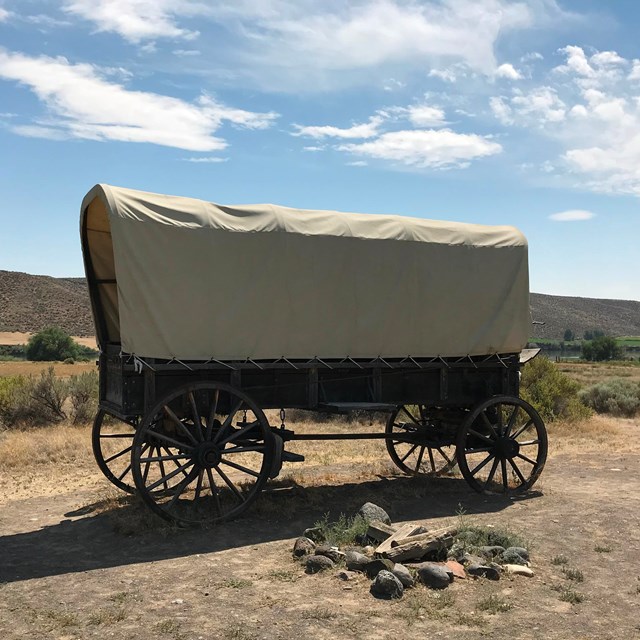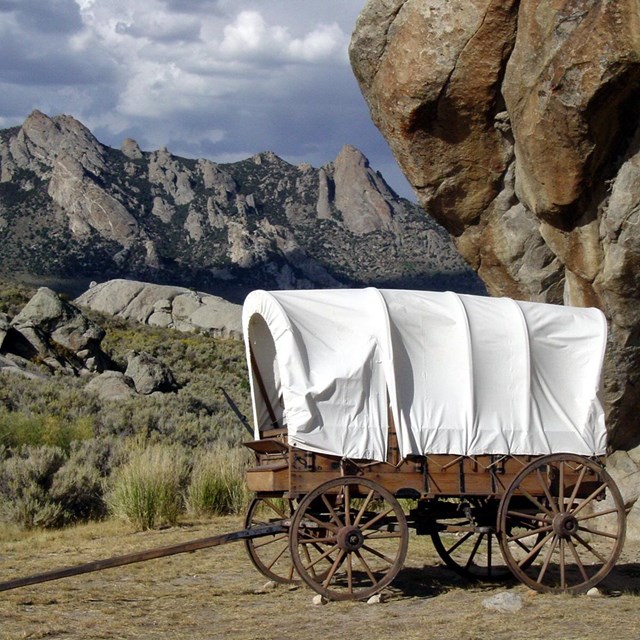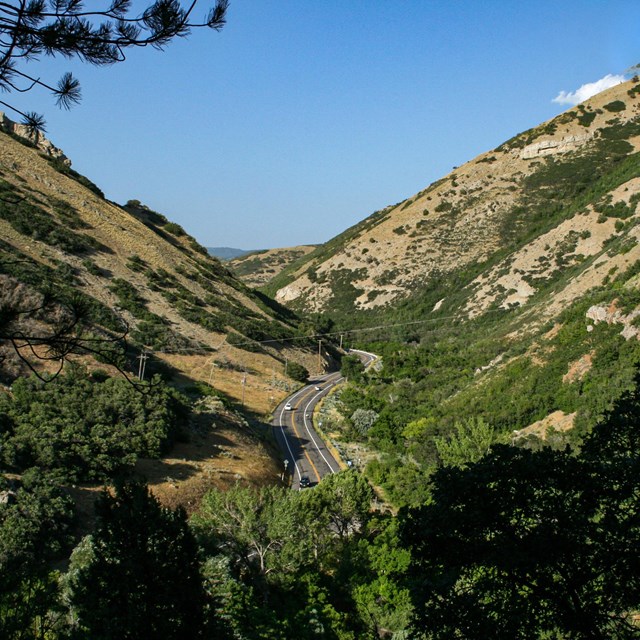Last updated: March 28, 2022
Article
Preface - Sweet Freedom's Plains: African Americans on the Overland Trails 1841-1869
Sweet Freedom's Plains
African Americans on the Overland Trails 1841-1869
By Shirley Ann Wilson Moore, PhD.
For the National Park Service
National Trails Regions 6, 7, & 8
Introduction/Table of Contents
This study examines African American participation in the great overland trails emigrations that occurred in the nineteenth century. It focuses on the history of African Americans on the California, Oregon and Mormon Trails from 1841 to 1869, when the transcontinental railroad was completed. The study explores three interrelated themes: black emigrants’ experiences on the overland trails, their perceptions of the journey, and their perceptions of the West and their new communities.
Chapter 1, “Race, Slavery, and Freedom,” discusses the early presence of people of African ancestry in the West and their roles in the exploration and settlement of the region. It also provides an overview of the changing status of African Americans, the state of race relations, and the nature and scope of slavery and freedom in the United States from the colonial era through the dawn of the great overland migrations of the nineteenth century.
Chapter 2, “The Jumping-Off Places,” focuses on the bustling river towns where black and white pioneers outfitted themselves for the trail. It explores the cosmopolitan and commercial character of the towns, discusses entrepreneurial black residents who made livelihoods from the overland trade and facilitated black (and white) emigration, examines the economic and racial barriers that impeded black overlanders, and discusses the strategies they used to overcome these obstacles. It concludes with a discussion of the ways in which free and enslaved blacks negotiated the perilous racial terrain of the jumping-off towns where they were especially vulnerable to foul play and slave catchers.
Chapter 3, “The Providential Corridor,” reviews the complex of overland trails, including the main Oregon, California, and Mormon Trail routes and the less-traveled southern trails. This chapter provides an analysis of the experiences and perceptions of African Americans on the trails. It discusses their contributions to the exploration, mapping, and development of the routes, examines their participation in the responsibilities and hardships that attended the journey, and looks at their interactions with Indians and their interactions with their white trail mates.
Chapter 4, “Sweet Freedom’s Plains,” looks at the expectations black men and women had of the West. It discusses the pragmatic and intangible factors that motivated them (enslaved and free) to venture across the plains in numbers that cannot be determined precisely. To evaluate the degree to which black expectations of the West were fulfilled, the chapter concludes with a discussion of specific African American emigrants and their varied experiences.
Chapter 5, “Place of Promise,” highlights the stories of a number of black pioneers who arrived in the West and began the process of community-building. This complicated task often included establishing themselves as free people first, then carving out a place in the emerging economies of the West, challenging the barriers that prevented them from achieving their goals, and sometimes, as the remarkable story of Rachel Brown in Ohio and her husband David Brown in California’s gold fields shows, making a complete break with their old lives.
It is difficult to speak of a “representative” African American Western experience because of the many unique circumstances that shaped black western emigration. The stories included in this report reveal the individuality of the black overlanders. However, their stories also show that black men and women who crossed the plains shared common experiences regardless of their status or the circumstances that set them on the western trails. What is most evident is that for the great majority of black overland emigrants, the West represented a testing ground for determining whether they and all African Americans could have a stake in the American dream.1
The nature and scope of African American participation on the trails prompt a number of questions that point to a need for a re-conceptualization of the migration narrative so that it more accurately reflects the nature, complexity, and racial diversity of the western pioneers. One of the key issues examined in this report concerns the extent of black participation in western emigration. How many African Americans went west? Estimates of the total emigration vary by hundreds of thousands. It is virtually impossible to produce a definitive figure for the total number of African Americans who made the overland journey. The research presented in this study suggests that every African American emigrant identified by name in the trails literature is representative of scores, if not hundreds, of other unidentified black emigrants. This challenges the popular assumption that the black presence in overland emigration was negligible.2
Related to the first question is that of identity: who were these African American overland travelers? While slaves made up a significant portion of black overlanders, free blacks composed a portion of the total. African Americans, enslaved and free, often held positions of authority and responsibility in wagon train companies. Sometimes financially secure, generous black emigrants covered the costs for white overlanders who were without funds to undertake the expensive journey.
Another issue in this study is the question of how black emigrants determined the end of their journey. Why did they decide to stop where they did? For African Americans, the overland journey was more open-ended than that of their white counterparts. Many African Americans experienced the overland trip as a series of sojourns along and detours from the Oregon and California Trails. Their approach to permanent Western settlement was conditioned by the racial climate that prevailed at the locations in which they stopped. A racially hospitable location and economic opportunity were the most compelling factors in determining when African Americans had arrived at the end of the trail.
This study also examines African Americans’ expectations of the overland trip. Clearly, black and white emigrants shared goals of economic advancement and prosperity, and both groups perceived the overland journey as a means to those ends. However, black expectations also were informed by a determination to leave slavery and oppression behind. This was doubly true for African American women who struggled under the dual yoke of racial and gender discrimination. Therefore, every step along the overland trails affirmed African Americans’ aspirations and agency.
This study considers black emigrant perceptions of the natural environment of the trails and the West. Reflecting their unique position and aspirations in nineteenth century America, some black overlanders (often trappers, traders, and mountain men) conferred their own symbolladen designations on geographic landmarks along the trails. Related to the issue of black perceptions of the natural environment of the trails is that of African American expectations of the West. Most African Americans, like their white counterparts, perceived the West as a pristine, natural environment that held the promise not only of freedom but of transformation. Black men and women also admired their new western home for intangible, aesthetic reasons in addition to the material benefits it offered.
Finally, the study examines the issue of how African American western emigrants fared when they reached their final destination. How did they fit into their new communities? How did they make a living? Was there a conflict between expectations and reality in the West? How did they establish themselves as free people in the West?
1 I am indebted to Blake Allmendinger’s discussion of a representative black western experience and the notion of the West and the American Dream. See Blake Allmendinger, Imagining the African American West (Lincoln: University of Nebraska Press, 2005), xvi, 15.
2 For examples of numbers of unidentified African American overlanders, see National Park Service, Historic Resource Study: Mormon Pioneer National Historic Trail, by Stanley B. Kimball (Denver: Denver Service Center, May 1991), 6; Rudolph M. Lapp, Blacks in Gold Rush California (New Haven: Yale University Press, 1977), 25-26; Quintard Taylor, In Search of the Racial Frontier: African Americans in the American West, 1528-1990 (New York: W.W. Norton, 1998), 83.




